How starting a podcast can help your brand
A podcast is a way to promote yourself, your brand and your team’s expertise to build the authority of your brand, and earn trust from your customers. Essentially, podcasting is a radio show that’s shared through the web. Americans may find it easier to think of it as an online, audio equivalent of their public access broadcasting. Back in 2004, it was a wild idea to start a blog to promote our brand and reach out to customers. It’s now an accepted fact that a blog is a fantastic opportunity for content marketing. Currently there are approximately 600 million blogs, while Apple have approximately 800,000 podcasts, meaning there are 75- blogs for each podcast. Time to get in at the ground floor!
Your Podcast will generally be about establishing that you and your brand are knowledgeable in your field, and can be trusted. A secondary benefit of this is that it can drive traffic to your website, both though mentions and links in the description, backlinks at the repository you use for your podcasts, or through being shared to others through social media, for example.
In addition, depending on how you plan and target its content, it can generate leads as well as building your profile and mindshare.
People are more likely to buy from a brand that they trust, and a podcast enables you to establish your knowledge and authority within a field. In addition, it can increase your reach beyond your ‘normal’ customers.
What is a podcast?
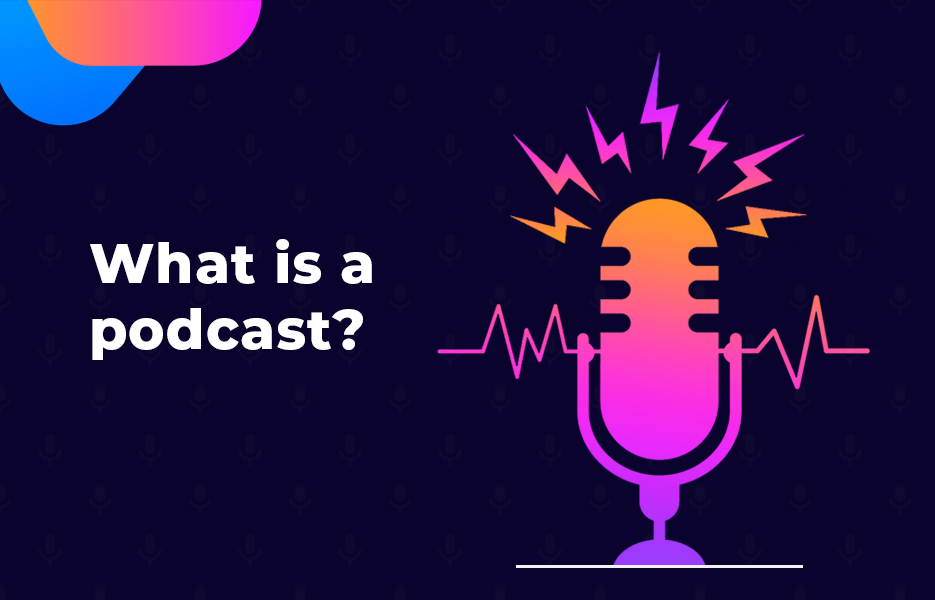
A podcast is, in essence, an audio recording of you and/or others talking about a subject. That subject, or topic, can be, well, anything – Travel, hobbies, business, finance, eCommerce… The current top 5 categories are Business, Comedy, Health, Society & Culture and News & Politics. 51% of Americans have listened to a podcast at some point. 32% of Americans listen to at least one podcast a month – 22% listen to them weekly.
Ultimately, it’s something that interests the person making the podcast, and hopefully a few people to listen to it (the audience). If there isn’t an audience, why are you doing the podcast?
On iTunes, there are more than 850,000 active podcasts, and more than 30 million podcast episodes in 100 languages. At WWDC 2018, that was 550,000 active podcasts and 18.5 million episodes, so it’s definitely a growing field.
How can podcasts help my brand grow?
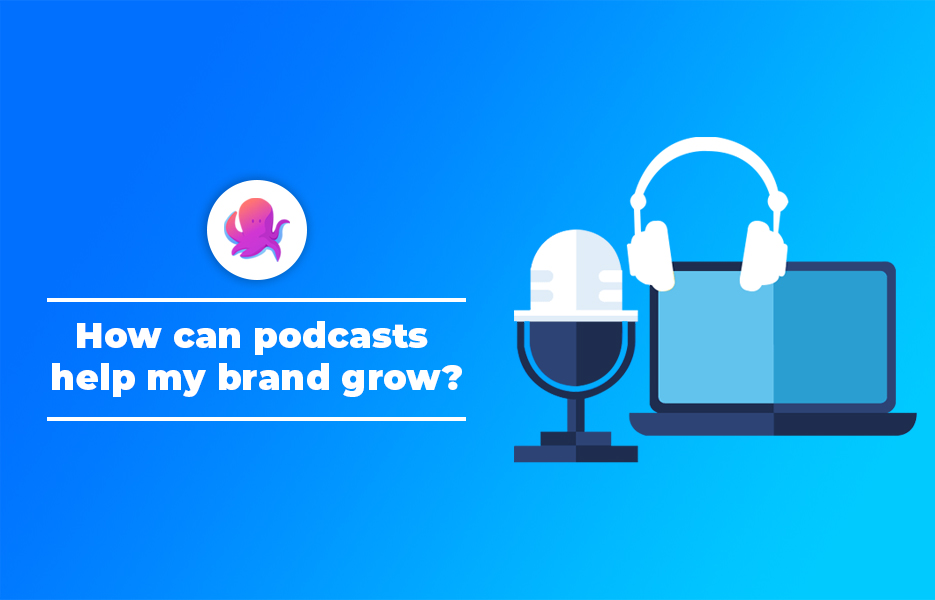
Podcast listeners are more active on social media, with 94% active on one channel or more, vs 84% of the population which doesn’t listen to a podcast. They are also more likely than the rest of the population to follow brands and companies on social media. This means that by engaging with people through podcasts, you can improve the engagement those people have with your brand, bypassing marketplaces like Amazon and eBay, for example to improve return business and direct recommendations.
What kind of content is common for podcasts?
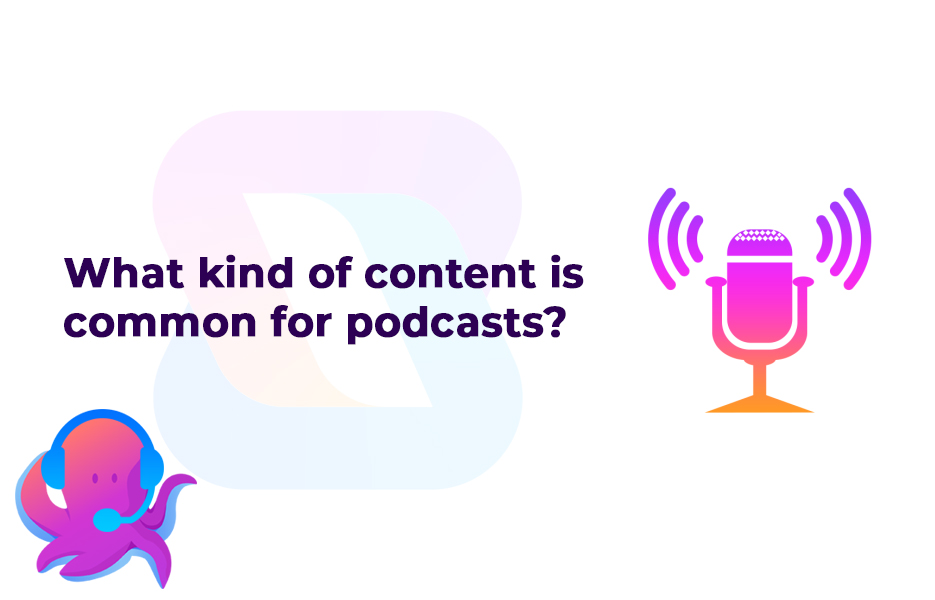
Podcasts tend to involve certain types of content – A podcast may have a mix of types between episodes, or may be of one specific type.
Firstly, how many people will be talking on your podcast? The simplest (and easiest to arrange) type is a solo podcast – One person and a microphone talking to the listeners. It does very much put the pressure and onus on the presenter to have a clear voice, and good pronunciation. There’s nobody else to distract from your voice.
Alternatively, you may have 2 or more people. At this point, the question is – Are they both presenters, or is it an interview podcast? Where there are multiple presenters, they can each take on a ‘role’ in the presentation of the material – One might be ‘the techy one’, one might be ‘the funny one’, for example. This allows everyone to trade off the presentation of information, and the listeners can identify what sort of subject or content is being covered by the voices. Their discussion can then illustrate different points on a subject, and help listeners get a well-rounded view of a subject as well as drawing conclusions or making recommendations.
An interview podcast may have several presenters and one interviewee, or there might be a different balance – you might interview a couple of guests together (Say partners), or you may build your podcast out of two or more consecutive interviews. With interviews, it’s good practice to research the subject and prepare questions in advance – This means that you will be less likely to ramble and lose control of the conversation. It’s important to have ‘soft skills’ to arrange and take part in interviews though – Arranging for people to take part is an art in itself, and benefits from them knowing you or a colleague and rusting you not to try and embarrass them or cause problems. This shouldn’t mean pandering, of course – if it’s just PR fluff, it may be hard to build up a following. Make sure that the interview has some content and personality to it! A good interviewer can bring out points and information even the interviewee hadn’t considered. But it’s a skill that needs to be built up – We can’t expect to be experts the first time!
What should I call my podcast?
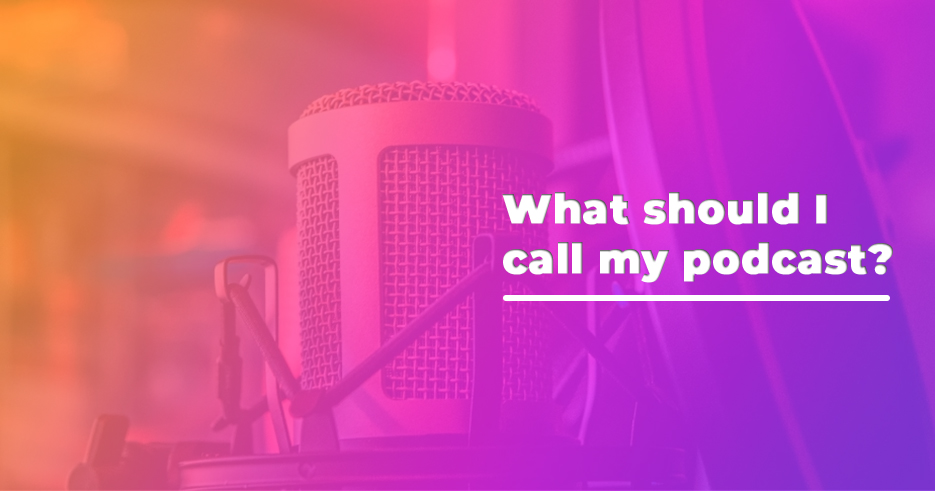
A podcast title should be catchy and memorable – Also bear in mind that it should if possible, use some well ranking keywords for you subject. We have written a post that might help you to find tools which will help you locate those SEO keywords.
Apple’s Podcast Best Practices say this about naming your podcast:
Pay close attention to the title, author, and description tags at the and level of your podcast. Apple Podcasts uses title, author, and description fields for search. The metadata for your podcast, along with your podcast artwork, is your product packaging and can affect whether your podcast shows up in relevant searches, and how likely users are to subscribe to it.
Make your title specific. A podcast named Our Community Bulletin is too vague to attract many subscribers, no matter how compelling the content.
So it’s a good time to think about what the world will know you and your podcast as. It will make a big difference in persuading them to give you a chance. But remember not to ‘stuff’ your podcast with keywords. Don’t use keywords gratuitously, as that will get picked up and will penalize you. You CAN use title tags and descriptions to elaborate on your title.
Where can I find podcasts?
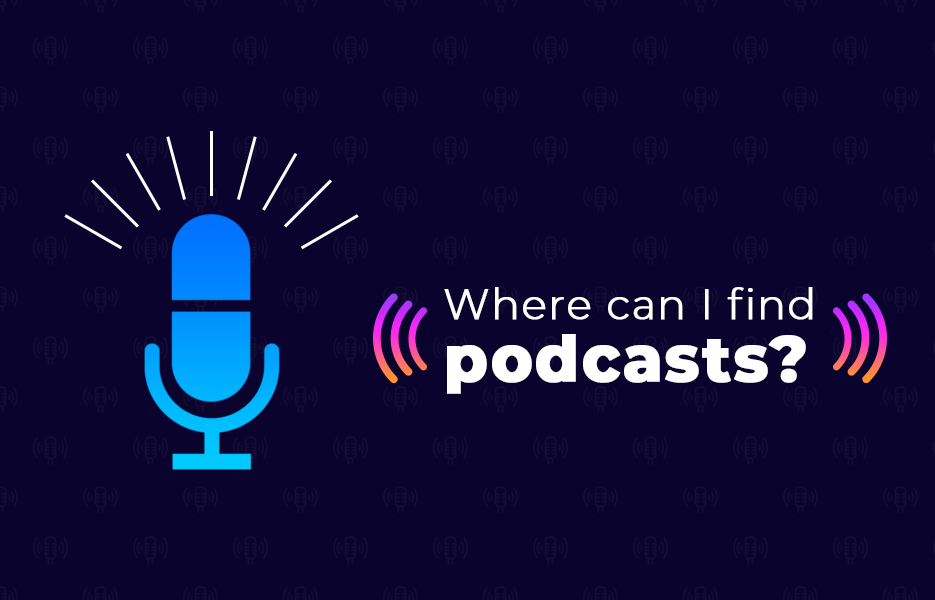
The most common places people look for podcasts are iTunes and Spotify. Some people host their own, of course, but you lose a lot of potential exposure that way.
Hosting Sites
Podbean
Podbean offers a range of hosting options, starting free and going up as far as $99 per month (When paid annually, or $129 per month if paid monthly). They also offer their own app, which can be used to record and upload podcasts.
Podbean can offer options for Ads and monetisation, patron programmes and even multiple channels in one account.
Captivate
Captivate offers a free 7-day trial, to let you make sure of your decision. It’s a good place to start you off, but then you need to pay to move forwards. They offer some great tools such as WordPress integration, RSS feeds, batch uploads and default release/scheduling times to help you to be regular and predictable in releasing your podcasts, which reassures your customers and builds loyalty and habits. In addition, you can customize your hosting page to match your brand easily, and the site is mobile-friendly – Very important when most podcasts are listened to on smartphones!
The different plans don’t limit how many podcasts you can put up – Just the number of downloads per month, so it will grow with your membership, and you can justify cost changes.
Buzzsprout
Buzzsprout is another podcasting platform that offers a free starter option, with a range of plans to grow into, supporting advanced features and offering longer term storage (The free account only stores podcasts for 90 days). They also regularly add new features that can add value to your podcast – transcription integration, for example, or chapter marker creation in your podcast recording.
Buzzsprout is also able to get your podcast listed on all the major podcast directories, such as Apple Podcasts on iTunes, Spotify, Google Podcasts. iHeart Radio, TuneIn, Alexa (from Amazon), Castro and PodChaser.
Transistor
Transistor is focused on brands and professionals, rather than hobbyists. This means that it has great quality analytics and tools, but may not be as cheap as some. It DOES offer a 2 week trial, though.
It supports multiple team members and roles, doesn’t limit the number of podcasts you host, and best of all, the player they provide on the website (For those who don’t browse on their smartphone) is independent of the podcast site – so people can browse while listening easily.
Podcast Apps
With smartphones being the most common way for people to listen to podcasts, there are a number of apps that are recommended for accessing them, as opposed to using your web browser. They often support streaming OR downloading, so you can pre-load podcasts before leaving the house and save your data plan.
Cross platform apps (iOS and Android)
Pocket Casts
Pocket Casts is a podcast directory as well as having an app that can be downloaded for iOS and Android, and offers a wide range of filtering options to find the podcasts that suit you. It can sync progress between multiple devices, letting you move seamlessly between a smartphone and a tablet, for example.
It supports chapter navigation, embedded artwork, volume boost (where a podcast is too quiet), it can trim leading or trailing silences on podcasts to speed up listening too. In fact, it can also vary the speed of the podcasts slightly, running it at half speed if they are talking too fast, or up to 3x the normal speed! Pocket Casts offers curated recommendations to get you going, too.
Pocket Casts is compatible with Sonos, Chromecast, Android Auto as well as Apple Watch and Android Wear watches to control it ‘on the go’. It’s free to download, but there are payment options within it
Stitcher
Stitcher is a free podcast app, though it has a subscription option to remove ads and listen to their original content. Its’ iOS and Android versions have won a number of awards, and it allows you to search not just for podcasts, but individual episodes.
Podbean
Podbean offer podcast hosting as well as an app. Available on iOS and Android, it doesn’t just offer access to a large pool of podcasts, with hundreds of 5 star reviews. Podbean will also allow you to record podcasts and upload them to a Podbean hosting account.
iOS
Overcast
While Overcast is free, it is ad-supported. This is offset by the fact those ads are targeted by category to promote other podcasts in that category, so giving you a chance to find new, interesting options to listen to.
It supports adaptive (smart) speed changes, volume boosting to make it easier to hear quieter podcasts, and you can filter and change the order of podcasts within a playlist to suit your preferences.
ListenApp
ListenApp is another free app on iOS, but this time it’s ad free. It supports custom queue/list creation, toggling which episodes and podcasts to stream and which to download, playback speed adjustment and other features.
In addition, ListenApp will offer recommendations based on your listening history and trending podcasts to help you discover new opportunities.
Catcher
iCatcher is not free – It will cost you a massive $2.99! There are some in app purchases, too
OK, so it’s not going to break the bank, but why would you pay for it, rather than using a free app? For starters, it’s incredibly customizable, so you can tweak it to your preferences, import podcasts from iTunes as you get more serious about podcasting, etc. for another thing, it’s a universal app. What this means is that it works on all Apple Devices – the iPhone, iPad and Apple Watch. It also supports video podcasts, and playing externally via an HDMI adaptor or Airplay.
It also supports gesture controls, so if you podcast while walking or running, or at the gym, it makes life a little easier.
Android
Podcast Republic
Podcast Republic has a dedicated following, and gets high ratings (81,000 reviews and five stars!) It’s first plus is that it’s careful to not ask for too many permissions – If it doesn’t absolutely need it, then it will not ask for it. Refreshingly different.
Podcast Republic supports RSS feeds and streaming/internet radio as well as podcasts. It currently offers more than 600,000 podcasts and more than 40 million episodes. That means one app will give you access to a great deal of information on a wide range of subjects.
The app offers gesture controls including shaking, prioritised and customizable playlists, variable playback speed and automatic download and deletion of podcasts after release and being listened too – don’t clog up your phone with gigabytes of old podcasts. It also supports external storage, so if your phone hasn’t got much space, you can save your podcasts to SD Card. It’s free, but has in app purchases and ads. Removing the ads is a one off purchase of £2.69.
Doggcatcher
Doggcatcher is £2.99 – It also has over 10,000 reviews and maintains a rating of 4 stars. It has been rated “The Best Podcast Manager for Android’ by the Lifehacker blog back in 2015, and was also rated by Android Central as both “Reader’s Choice” and “Editor’s Choice”.
I supports Android Auto and Chromecast, so you can listen wherever you are uninterrupted. It automatically downloads and optimizes the podcasts you’re subscribed to, and supports continuous playback.
What are some examples of good podcasts?
Exponent
Exponent is a blog about the trends shaping the tech industry. Focussing on business rather than cultural implications, host Ben Thompson (writer of the blog and newsletter Stratechery) and James Allworth (head of innovation at Cloudflare) take a strategic view of the tech industry every two weeks (or so). They look at the big picture, and the trends which are driving the tech industry, as well as putting it into historical perspective. Exponent helps you to get an idea of where things are going next. All this in just an hour.
Eat, Sleep, Work, Repeat
Eat, Sleep, Work, Repeat is released every Monday, lasting 30 to 50 minutes. It looks at how individuals and businesses can improve workplace culture, and is hosted by the European vice president of Twitter, Bruce Daisley.
The podcast is centred on Daisley interviewing guests each week for insight about different aspects of the workplace, and workplace culture – a great shortcut if you don’t have time to read 2 or 3 books a week! Guests have included Cal Newport on digital minimalism, and Sue Unerman on gender equality.
How I Built This
How I Built This is a podcast made my NPR (National Public Radio) in the US. They release it every Monday, and it lasts between 45 and 60 minutes. The host is Guy Raz, and he talks to a different entrepreneur each week about how they built their business, and overcame challenges. Previous interviewees have been involved in businesses such as AirBnB, Ben & Jerry’s, Instagram and Starbucks. It offers some interesting insights on the challenges you might yet face, or are facing as a business owner.
Reply All
Reply All is hosted by PJ Vogt and Alex Goldman. The Guardian says it is “A podcast about the internet that is actually an unfailingly original exploration of modern life and how to survive it”. Reply All takes an insightful look at how people and technology affect each other.
Digital Planet
Digital Planet is a tech podcast from the BBC. It often focuses on the internet and social networking, and provides an alternative viewpoint to many of the American podcasts.
Alphachat
Alphachat is a podcast from the Financial Times, with host Cardiff Garcia discussing a number of topics with economists, authors, financial advisors and other leading professionals to give you new insights.
Seriously…
Produced by BBC Radio 4, Seriously… isn’t about any specific thing – It varies in length from week to week, but each week it covers something different – From the origin of ‘Ok, Boomer’ to elections and education, even Facebook. It might be a great way to round out your day with something non-work related.
What is a private podcast?
A private podcast is different in one main way – You can limit who can access it. They’re generally used for internal communications – It’s a great tool for large, and growing companies to maintain a sense of community, or even to send updates to investors or shareholders regularly without them needing to all be available in one place or at the same time. Usually this will mean that you can give people logins through a portal to see the private podcasts and listen to them, while managing those user privileges.
It’s worth checking if this is supported by your podcast host, and whether it requires a separate account. Looking to those above, it’s supported by Transistor, and Podbean, though there are plenty of hosts not covered int his article that may be perfect for you.
What should I put IN my podcast?
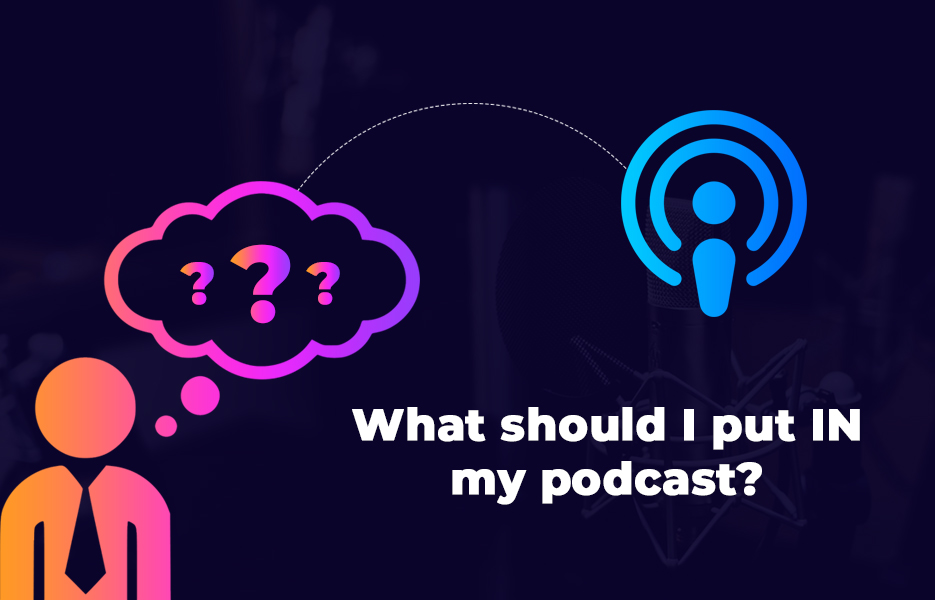
It’s usually good to have opening and closing statements to ‘bookend’ your podcast – Start by introducing yourself, the podcast, and what will be happening. Finish up with a conclusion, summing up what was covered, who else was there, and if appropriate, direct people to your site for additional information. You might want to tease what’s coming in the NEXT podcast, and when it will be released.
The middle though – Now that is the trick! And that’s what will make people come back to listen to you. Don’t be afraid to practice and run some tests past your friends or colleagues to see what works, and what doesn’t – it can help you to avoid problems later!
Don’t forget, though – You need to be relaxed at the time of the podcast – it will come across to the listeners, and, if you’re doing interviews, it will come across to your interview subject!
How often should I record my podcast, and how long should it last?
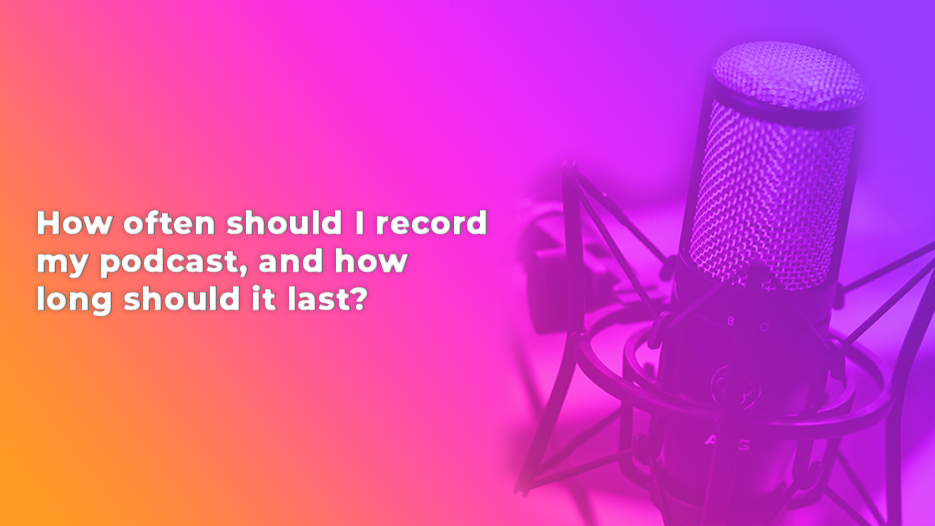
The frequency is very much subjective – Some topics lend themselves to once a month, others might be daily – It depends on the length, too. It’s easier to record a daily podcast that lasts 10 or 15 minutes and spread discussion out, then to record a weekly podcast that’s in depth and lasts an hour or two.
What your audience can last through will also determine length and frequency, of course!! Where you need more detail, or are covering more content, a longer podcast should be acceptable.
There are some ideal numbers that you can bear in mind, though.
What’s the ideal length for a podcast?
According to Stitcher, the average listener stays engaged for 22 minutes, so it might be worth starting shorter and building a following. But if you need to feature more content, then consider greater length per episode.
How often should I release my podcast?
If you look at the top 25 podcasts, you will find that 44 percent of them publish one episode per week. Following this is twice a week. Remember, if the amount of material you want to cover would make our podcast longer than you would be comfortable with, then consider recording that material and splitting it across ore release days.
When should I release my podcast(s)?
The most popular day to publish a podcast would be Tuesday or Wednesday – 60% of podcasts publish their schedule in advance.
How hard is it to start a podcast?
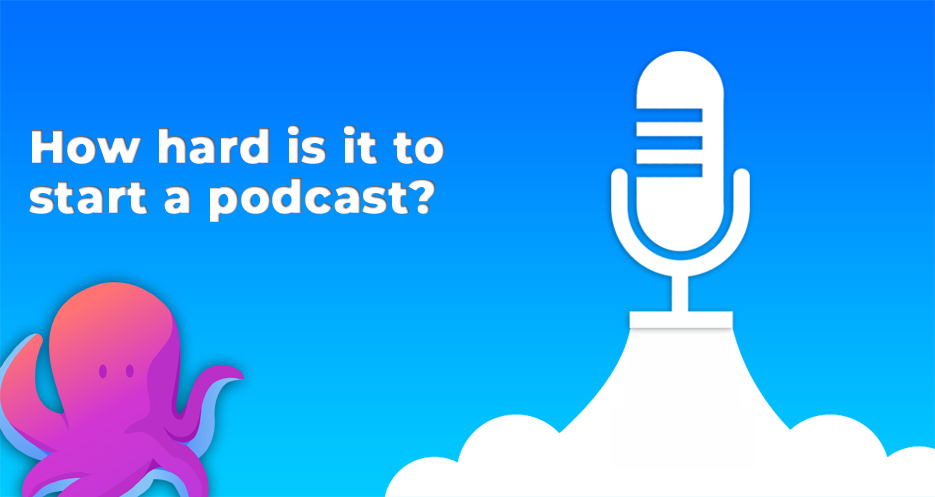
Not hard at all – You can record a podcast on your phone if you want! There are a variety of free tools you can use, and of course the better quality podcasts need extra equipment and tools of course, but there are many stages in between.
What is your niche?
It’s good to do some preparation in advance of doing a podcast. Find other podcasts in the same subject or industry area and listen to them. See what they do, and think about what is ‘good’ or ‘bad’, so you can learn from them what works. Listen to them throughout their growth, too, and see what did and didn’t work for them as they learnt.
Finally, ensure that there is a space for you. And if you think that there is a lot going on but you still have something to bring, also look at when your ‘competition’ are releasing, and consider coming out the day before or after. Who listens to these podcasts and when do they listen to them. Engage with other listeners through social media, for example. Is it worth releasing at an unusual time as an experiment, like Sunday, for example? Don’t be afraid to ask strange questions to prospective listeners. Don’t forget, though, you need to build up a following to make your podcast viable. Once you have a core audience, and you’ve engaged with them and their feedback, you can start to grow that audience.
What tools do I need to make a more professional podcast?
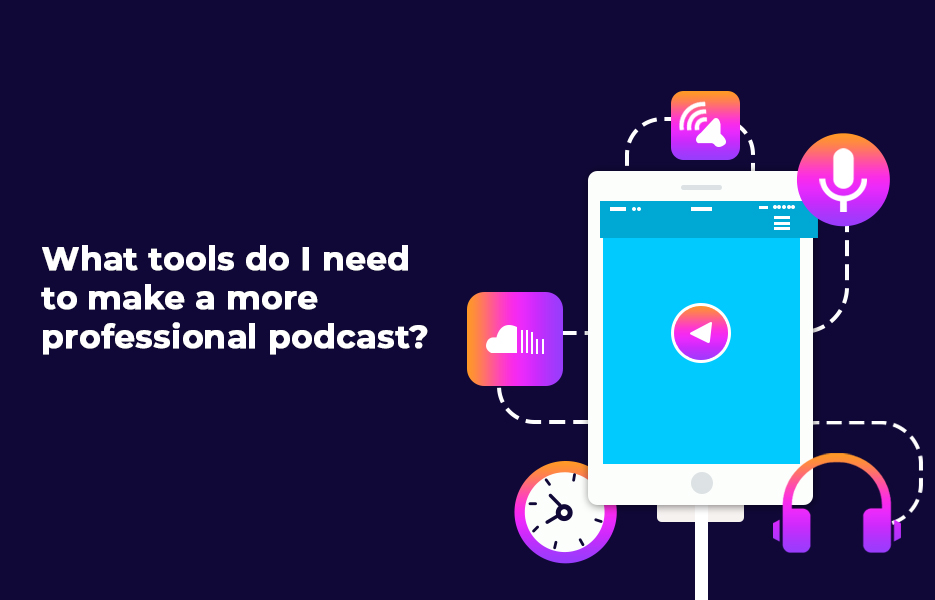
As mentioned above, the most basic equipment to create a podcast is sat in your pocket, or on your desk right now. Your smartphone contains a microphone, a powerful processor and storage (as well as wireless internet access).
But, ideally, get a dedicated microphone – you can get fairly respectable USB microphones or headsets relatively cheaply.
Script/outline
Before you record, at least have some notes ready about the points you want to cover, and in which order – If you can add more notes or hints, then your final result will be better – It’s surprising what you can forget once you click ‘record’.
Location
Pick a location to record which is quiet, and where you won’t be disturbed – Preferably with a locked door AND a sign on the outside saying ‘keep out’ and ‘don’t knock’, along with the obvious ‘quiet!’. You don’t want to have to re-record because people were talking loudly in the next room and the walls are thin, and the less work for your editor, the better. If possible, have a space where you can leave everything setup (microphone etc) so that you have less risk of dropping or bashing things.
In addition, if there is more space in the room, then you’ll get better acoustics (Plus there will be room for guests and co-hosts!). don’t forget to have a drink to hand – water is good, as it won’t hiss or crackle (carbonated drinks) or go cold if left too long.
Hardware
Microphones & accessories
USB microphones are surprisingly good now, with the increasing capabilities of relatively cheap components that were once ‘professional grade’. There are a variety of price points that you can target when preparing, and you can always upgrade equipment as budgets change, or needs change (More people talking, for example).
Rode NT-USB Microphone (£122)
This USB Microphone from Rode, comes with a decent stand and controls, but it’s main plus is the whole package, such as a pop shield, case, desktop stand, a long USB cable (20”) and well-featured software.
Blue Yeti USB Microphone (£119)
Blue are a well-known brand in podcasting and microphones. Their Yeti is a mid-range offering with its own stand, a respectable length of cable and higher quality condenser capsules which, because it’s connected directly, bypasses any issues that there might be with the sound card on your PC.
Shure SM58 vocal microphone (£106.74 + accessories)
The Shure is a professional microphone, often seen in the hands of a singer. They’re robust (The phrase ‘Drop the mic’ comes to mind, and these can withstand that). This means they will be great if out and about, as well as in the ‘studio’.
They are professional microphones, and perform well, but you will need a stand, an XLR cable, as well as either a specialised interface for your PC or a good sound adaptor/sound card.
Pop filter (£6.99)
When you talk into a microphone, it can pick up and amplify the very quiet noises from your lips as you speak (pops) and these can be very distracting. A pop filter is put between you and the mic to ‘absorb’ or deaden the noises. This can make your recordings much cleaner, and easier to understand.
Headphones
If more than one person is talking, especially when you’re not all in the same place, then using headphones will make it easier to avoid echoes and distortion on the recording, which will also help you and any others to give ‘cleaner’, more natural performances without hesitation. What is comfortable for one person might not be for another. Don’t be afraid to go to a store and try some on!!
Sony MDRZX110 headphones (£32.27)
Sony’s ZX-Series headphones aren’t Bluetooth, they don’t have a microphone or flashing lights, and they are wired, so you can’t just wander away from the computer without checking or taking them off.
What they are, though, is solid, comfortable headphones with good sound quality for when you are going to be wearing them for a while. They’re also fairly robust, so they can stand up to being dropped, or you forgetting to take them off when you get up and reach the end of the wire.
Audio-Technica ATH-M20X Professional Headphones (£38)
These large, wired headphones offer enhanced audio quality, and their larger earpieces are designed to make them more comfortable, particularly for people with larger ears. They are well built and resilient as well, so will last you a long time. In addition, the ear cups are articulated, so you can flip one away ‘DJ style’ to allow you to hear the audio AND the real world.
Audio Interface
Focusrite Scarlett 212 USB Audio Interface (£121)
If you’re using a microphone like the Shure, then you will benefit from using a preamp to improve the quality and balance of your recordings. The Scarlett is one of the most popular option for this because of its capabilities and price point, and it’s also a USB interface, bypassing the limitations of your computer’s on board/existing sound card. In addition, the software provided with the Focusrite will help you to get better results and a cleaner recording.
Portable Audio Recorder
Zoom H6 6-track portable recorder with stereo microphones (£308.44)
When you get out and about, or visit an event, you might want to grab on the spot conversations or interviews for later use in your podcast. You CAN use a mobile phone, but a higher quality recording will make it easier for listeners to make out what is being said, and by having a stereo microphone, people listening will be better able to separate the speech from background noise. It saves to SD Cards, so you can swap storage through the day to capture everything, and supports Bluetooth for synchronising when you get back to the office (or home), and working on the recordings in your editing software.
Microphone Boom Arms and mounts
Rode PSA1 Swivel Mount Boom Arm (£62.50)
The best way to get a clean recording is to have the microphone suspended before your mouth at a reasonable distance, but also to isolate it from vibrations such as people slamming doors or scraping chairs, so the vibrations aren’t transmitted through the base of the microphone. In this instance, the suspension arm holds it in one place consistently (and your arm won’t get tired).
On-stage MY420 studio microphone shock mount (£29.20)
In addition to the boom arm, the shock mount holds the microphone at one end, the arm on the other, and protects the microphone from vibrations in the environment that may travel through the floor and furniture (Doors slamming, dragged furniture, etc).
Software
Audacity (Free)
Audacity can be used on Windows, Linux or Mac, and it’s open source – So it costs you nothing to get it installed and working apart from time. It’s multi-track audio editing software, and so it’s great for reviewing and editing your podcast recordings. There are more expensive packages out there, but they aren’t necessarily ‘better’ for podcasting. And because it’s free and used widely, there’s lots of free (and paid) guides out there to help you get the most from it! In addition, because it’s open source, it’s updated quickly and regularly – it has a development team of thousands, if not millions!
GarageBand (Free)
Preinstalled on all Macs, whether laptops or desktops, GarageBand is good, basic piece of software to record and edit audio tracks, and has launched a thousand demo tapes and podcasts. It’s probably more intuitive and easy to use for a beginner than Audacity.
It’s definitely a good option when you’re getting started and you can then see where you go as your podcast grows and your needs change. There’s lots of guides to get the most from it online, and plenty of people in various communities can answer questions or give advice.
Adobe Audition (Creative Cloud subscription, from $19.99 per month)
If you’re using other Adobe programmes, or if you need to use something more ‘recognised’ by industry, consider Adobe Audition. Audition might be a little over the top at first, but as you update the equipment you use, and the quality and complexity of your production, it could be a valuable tool.
It might even be that you choose to start with it, so you don’t have to transition software later. It’s worth considering if the resources are there and not needed for other areas, or if a member of the team already knows how to use Audacity.
Hindenburg Journalist (starting from £76)
Hindenburg is a highly capable piece of audio recording software, and it’s Journalist edition is focused on journalists and podcasters. It supports recording, multitrack editing, adding in sound and music from other sources as well as publishing the finished file. It won’t make you worry about stereo, mono, bit rates or sampling rates – Just drag and drop, Hindenburg will make the best of what you have. It also uses a ‘clipboard’ model to help you see and pick out different audio ‘clips’.
And as icing on the cake, it even offers a 30-day trial!
Other Resources
It’s useful sometimes to have music or sound effects for your podcasts, to make it sound more professional (Especially when it starts and ends). Like images and videos, there are people who make their work available free for use, or for a small fee or subscription. Always make sure you’re not breaking the law and risking legal action by using music or other creative works without the right license.
Fiverr
Fiverr is a site where you can commission someone to perform bespoke work or tasks for you, including music composition, with you owning the end result. Fiverr has a longer lead time, and you will take a little risk because you can’t just listen and say ‘yes’, but you will get something that’s unique to you.
Pond 5
Pond 5 is a site full of audio and video resources to use in your creative works. They offer royalty-free music and other assets for a one-off fee to be used commercially.
Subscriptions start at free, and increase. Free is, in effect, pay as you go, and you simply pay the value of the clip, starting as low as £22. Memberships can massively reduce costs per clip (or other item) if you’re going to get a lot of use from it.
Audio Jungle (From $1)
This site contains a wide range of royalty free, free songs, as well as songs at price points starting from $1 upwards.
What’s a good format and settings to use?
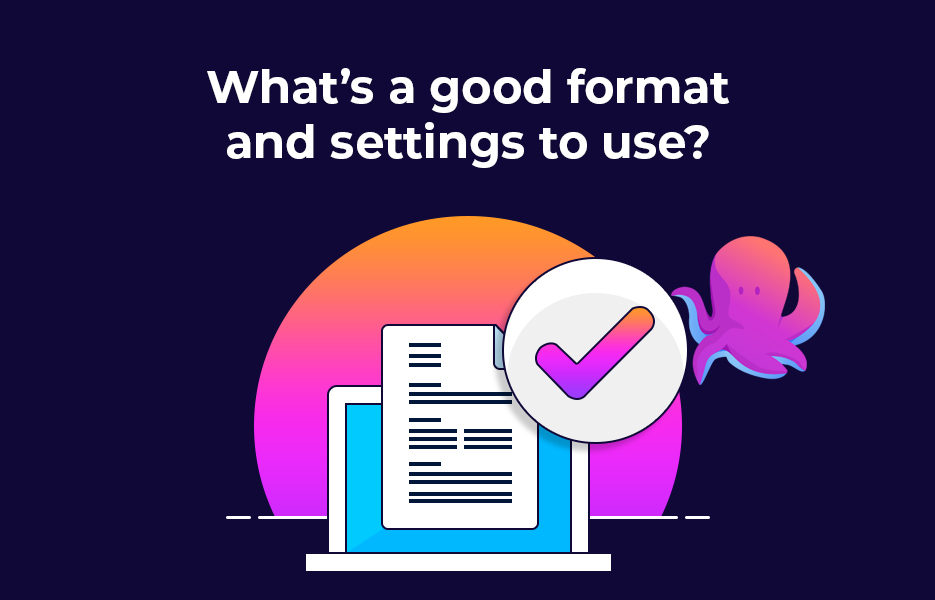
Check with the hosting platform you’re going to use, of course, but a good baseline would be an MP3 file, with 96 kbps mono for spoken word content. You might also want to consider filling in the file’s ID3 tags, to make sure the player the listener uses can show the right information about the title, presenter, etc.
Artwork?
Don’t forget that you can/should look at some artwork and graphical representation to attract listeners. It’s as much a part of your brand as the podcast itself, and will get the attention of others (But shouldn’t be too bright and gaudy). It should illustrate to some extent what your podcast is about, and represent it properly.
Creating a podcast can be a one-man operation, or a multi person team effort. It can grow from one into the other, too. But start simple, and give yourself time to try and fail a little before going live. Especially if it’s your first time. There’s lots of free tool and options if you want to start simple, but they aren’t so limited that you have to feel bad. Make the best of the equipment you have, but make sure you have good content to talk about, because that’s what people are looking (listening) for.
When you finish your recording, and edited it, exported it (based on the formats your host prefers) and uploaded it, then you’re going to have to do the hard part – let it out in the world and see what people think. You can run it past friends and colleagues first for feedback, but once the general public have a listen, you will need to learn to separate constructive criticism out from the complaints, and to evaluate what will please only one person as opposed to what will make it more popular. It may not be easy, but as you learn and you work through the feedback, you’ll have a better product, and it will have more value to you, the company and the brand. And, ultimately, that’s the point, isn’t it?
Don’t be afraid to make changes if they add value and improve the product. You will grow and change, as will the podcast (and your audience). A podcast is a living entity, and it will grow and change over time.

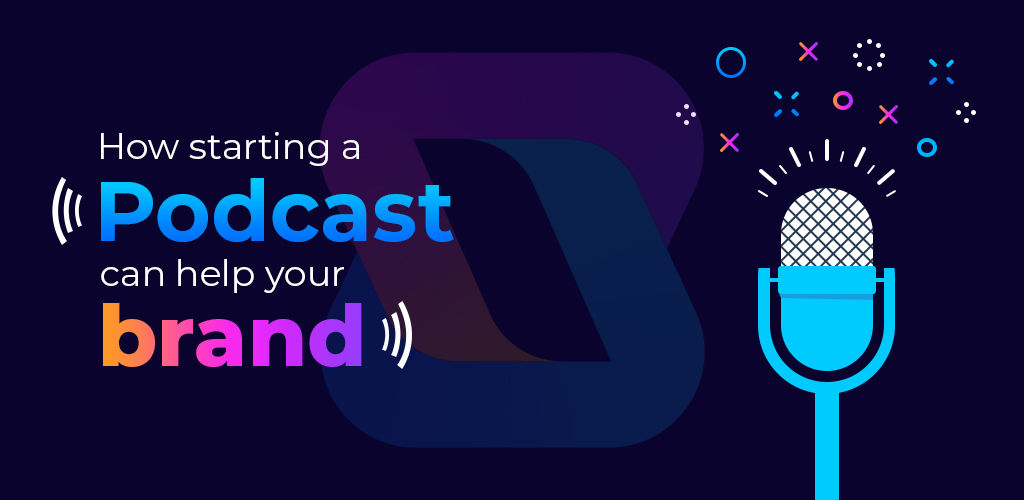





DropShip products from verified suppliers to diversify your inventory and scale your eCommerce business